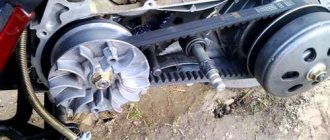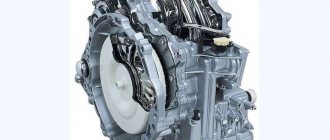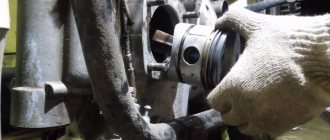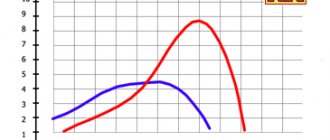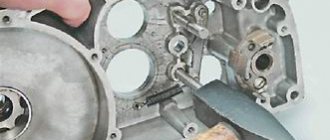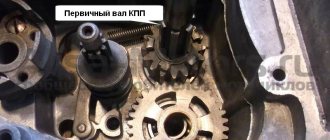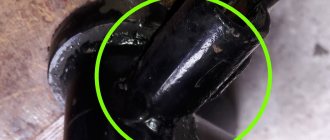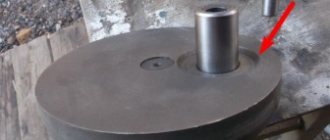Scooter variator device
A variator is a part responsible for a smooth change in speed. It is a unit of two pulleys (driver and driven) connected to a belt. The degree of load on the main variator depends on the intensity of engine rotation. When driving at high speed, the number of rotations is maximum, which is why the variator parts wear out faster.
The belt is attached to the pulley at the sides. If the CVT bushing wears, the belt cuts deeper into the pulley. When the drive pulley operates, the belt smoothly compresses and unclenches. A sports CVT on a scooter makes more revolutions. The belt may need to be replaced sooner.
Even a new scooter can fail over time due to improper use.
Radius run
A more correct formulation for the technical characteristics of the scooter transmission would be the following: “automatic continuously variable.” In fact, we are talking about such a type of transmission as a V-belt variator , which appeared quite a long time ago, but due to its characteristics, it received the greatest development on scooters, as well as on snowmobiles.
The design of such a transmission is much simpler than a classic manual gearbox, and even more so than the notorious “automatic machines” that cars are equipped with (by the way, some representatives of the four-wheeled world also have a CVT, but a different one than on scooters). It is very simple to understand how a variator works if you remember the system for changing gear ratios on bicycles: several sprockets in front, several in the back, and they are connected by a chain.
How to replace a belt
The scooter's variator can withstand a mileage of up to 6 thousand km. The belt lasts the same amount of time. The part may last longer, but you still need to regularly diagnose it. You can do it yourself if you have special knowledge in this area.
Symptoms of a problem
- When the speed increases, the engine rotates quickly, but the clutch does not work. In this case, the transport does not budge. This means the belt has broken.
- The carburetor is normal, but it is still impossible to reach the maximum speed. The reason is that the variator does not reach its maximum radius due to damage.
- The belt lasts very little if it is a cheap fake. You need to disassemble the device and evaluate the appearance of the belt. If it is stretched, then it's time to change it. Due to deviation from the desired value, the transmission stops working as it should.
Main causes of failure
The main causes of CVT malfunctions are violation of operating rules:
- rare oil changes;
- use of low-quality oils;
- aggressive driving;
- sudden braking;
- long trips at top speed.
Mileage up to 6 thousand km.
withstands the scooter's variator. The reasons for the breakdown may be other. One of them is a faulty bearing in the variator, which manifests itself in the appearance of a hum. Noise is often attributed to worn wheel bearings, making it difficult for a beginner to identify the real cause of the problem. The difficulty is that the bearings can be damaged even with low mileage due to aggressive driving.
Another cause of damage is metal dust. The chain and variator pulleys rub against each other, so they gradually wear down.
Dust gets into the oil and then to the bearings. To find this dust, oil filters are present in the design. But neither they nor regular oil changes prevent the appearance of dust.
Another reason for variator failure is the accumulation of metal dust in the oil pump. It penetrates the valves and disrupts their operation, and also leads to pressure surges in the pump. The pulleys move chaotically, causing the belt to wear off. As a result, the vehicle jerks while driving. If you don't fix the variator, you'll have to replace the gearbox.
The variator may fail due to belt damage. This part is a device consisting of many plates located on a bundle of metal strips. Due to the uneven surface, they are better attached to the pulleys. They gradually wear out, and accumulated dust prevents the device from working properly. Because of this, the variator belt slips, jerking the vehicle. In this case, repairs are required immediately.
Due to belt damage, the variator may fail
The most harmless malfunction is that when driving fast, a sign flashes on the panel, indicating that the transmission is overheating. The vehicle stops abruptly to cool down. This indicates that the oil pump cooling system is clogged and has stopped working normally. For preventive purposes, it is necessary to clean radiators twice a year.
How to choose a new one
Scooter belts vary in size and markings. The characteristics are indicated in the transport passport. You cannot fit a larger belt size. Because of this, the dynamics of the vehicle may be disrupted.
Example. The driver changed the belt, after which the variator began to operate in normal mode. But, when squeezing the maximum speed, the belt tore into pieces. The reason is the incorrect choice of belt size. It is necessary to follow the characteristics in the passport. It is allowed to install a belt 1.5 mm larger than necessary. When the maximum radius of the variator was reached, the belt slipped out and caught on the edge of the pulley.
The belt could not cope with the sudden increase in speed and broke. To increase the durability of the variator, you should install a belt of the right size.
How to install correctly
The first step is to remove the damaged belt.
Scooter belts differ in size and markings
You need to place the scooter on the central leg and perform a number of actions:
- Unscrew the front variator located on the left side.
- Remove the kickstarter foot if there is a cover that might interfere with further operations. To do this, you need to unscrew the fixing bolt, after which the foot will be removed from the slots.
- If the device does not have a casing, you need to pull the main pulley so that the spring stretches. Next, you need to rotate the crankshaft, pulling the belt in parallel.
- The drive pulley must be removed if the belt cannot be pulled through it. To do this, you need to unscrew the clutch nut.
How to set the ignition on a scooter - an eternal question and a simple answer
Operating a scooter and enjoying its ownership brings a lot of positive emotions to the owner. In general, a scooter is a truly unique motor scooter, which is an almost universal transport. The scooter is great for driving around the city and for traveling outside of it. And everything would be fine, but sooner or later the moment comes when it has to be repaired and maintained, something that motorcyclists like to do much less of. Also, you often have to adjust and set the ignition, which few people know how to do correctly. It’s exactly how to set the ignition on a scooter that will be discussed in today’s article.
Replacing the variator yourself
At this stage, it is important to remember about the calculation of the variator. Installing an incorrectly sized belt will cause the device to quickly fail. To maintain the durability of the variator, the belt must be secured in the drive pulley. Then rotate it until it is positioned properly. Next, you need to check the quality of the fastening of the nuts, since they could have become loose during operation. Finally, you need to test the belt. To do this, rotate the crankshaft, after which it will become clear whether the belt is positioned correctly. If yes, all that remains is to return the variator cover to its place.
Replacing the variator yourself
There is a second way to replace the variator chain. Removing the old belt is done in the same way. Next, you need to disassemble the variator and install a pulley on which the new belt will be mounted. To push the belt in, move the pulley halves apart. The belt will take the required position after turning the variator at maximum speed for several seconds. If everything is normal, then the last task remains: how to assemble the variator cover? Everything is very simple. You need to screw it to the workplace and check the quality of the bolts.
ProVariator.RU
In this review, I will talk about the variator belt that I chose for my Chinese scooter, I will look at issues such as price, quality, belt sizes and at the same time I will show you how to change it.
Actually, this is how we became acquainted with the variator belt.
Which variator belt to choose for a Chinese scooter?
As with most Chinese scooters, the dimensions for mine will be 729×17.5
If in doubt, just take your broken belt and look at the dimensions on us.
There were three options for the Chinese scooter:
No thanks, even for sale, I'll buy something better. Last time I pushed the scooter for 20 kilometers. I feel sorry for the people. ))))
My clutch was so loose that it was shaking, and since I didn’t know about it, the belts had to be changed 3 times. And three times I chose this one. In a situation in which it could break on the first day, I skated for half a year.
And the third option is really cool, it costs one and a half thousand. Is it needed? Well, if you are going to go to Crimea on a scooter, then why not?
How to change the variator belt?
It's called a pneumatic impact wrench.
Unscrew a few bolts. And we see:
This is how the belt should be. It will hang around, torn, or even crumble into crumbs.
Yes, yes, that’s what this wonderful tool is for.
Don’t put pry bar keys and other nonsense in there, otherwise you’ll just ruin the gear and cost yourself an extra thousand rubles.
“Guys, do you have a pneumatic impact wrench? Can you unscrew two nuts?
When they are removed, we check the videos:
Then we take the clutch and try to squeeze it:
If it moves tight and smoothly, you're in luck! If it's loose, you'll have to buy a new one.
Well, the easy part remains. We tighten the belt and assemble our scooter.
NO NEED TO LUBRICATE ANYTHING!
Yes, if you bought a new clutch, it will not be easy to tighten the belt. We'll have to do it together. One pulls the clutch by hand, as shown in the previous photo, and the other pulls the belt onto the shaft.
Resource of piston scooter: Chinese four-stroke with 139QMB engine
We will consider the most common version of this engine with a cylinder volume of 72 cm3 (many round up to 80) and, accordingly, a piston diameter of 47 mm. The vast majority of Chinese fifty-kopeck cars have such an engine.
The service life of a piston scooter is a relative concept, as it depends on many factors:
- the quality of the scooter itself;
- driving habits;
- timeliness of maintenance;
- quality of motor oil;
- oddly enough, from your luck.
So, in order to decide on a resource, you need to set the initial parameters. This is what we will do:
We take one of the most common Chinese - “Viper”. For example "Viper Storm 50". This scooter has a fairly good quality engine (for a Chinese). Similar models from such manufacturers as Alphamoto, Fada, Skymoto, SpeedGear, Kanuni, Yaben, etc. are of approximately the same quality.
You can drive carefully at a speed of 30-40 km/h and at the same time carry only your butt. Or you can use the moped as a truck and transport, for example, several bags of cement at a time. You can even try to take part in HardEnduro competitions. For those who don’t know, HardEnduro is an endurance race over rough terrain, with a huge number of difficult obstacles to overcome - rocks, logs, jumps, steep climbs, steep descents, impassable mud, etc.
Here, perhaps, we will also choose the middle - we will drive relatively carefully, 40-50 km/h, sometimes give friends rides, and less often - bring home a bag of potatoes.
There are not many options here:
Here, too, everything is simple - we pour good oil, from about 120-130 UAH. per liter (price as of October 8, 2017), it can be more expensive - it definitely won’t be worse. Of course, there is oil for 40 UAH. per liter, but I really doubt it’s worth checking its quality on your scooter.
A piston can die without traveling even a couple of tens of kilometers. Yes, this happens with Chinese scooters. The piston retaining ring, which was inserted crookedly at the factory, may fall out and kill the cylinder. The piston rings may initially be installed incorrectly and get caught in the intake port, and also "GameOver". Due to the untreated crankcase casting, the channel for oil circulation from one half of the engine to the other may simply be closed and, accordingly, everything will end very quickly. And in general, anything can happen - this is China! To our great joy, such cases do not happen often, and one might even say, rarely. We, perhaps, by default will consider that we were lucky with the purchase of a scooter, in the good sense of the word.
- The quality of the scooter, i.e. manufacturer.
- Driving style.
- Timely maintenance.
- We change the oil every 2000-3000 km.
- We often check the tightness of the air filter pipe, the integrity of the filter itself, and monitor the correct operation of the engine cooling system.
- We check the valves on time (according to the manual) and, if necessary, adjust them.
- Checking the oil level in the engine.
Be sure to keep an eye on the air filter element: if it starts to get dirty, wash it, if it starts to tear, replace it.
In general, we do everything as it is written in the “book”.
Of course, you can forget about all these details, but this can lead to a global reduction in the life of the piston, and the engine as a whole, up to several tens of kilometers.
Business wisdom
The variator belt + on a Polaris snowmobile acts as a fuse that protects the snowmobile transmission from overloads. The general operating principle of a snowmobile transmission is quite simple. The variator belt transmits torque from the engine to the reverse gearbox. And he, in turn, drives the huge track drive gears. The resistance to movement in deep snow is very high. For this reason, snowmobiles are equipped with high-torque engines. In order to avoid serious overloads and breakdowns of the reverse gearbox, breakage of the caterpillar track, and damage to the drive shaft bearings, the variator belt is deliberately made to be the weakest point of the transmission.
Yamaha snowmobile transmission device
If the load increases, the belt slips, protecting other elements from damage. Why do some snowmobilers have a belt that lasts several thousand kilometers, while others require replacement after every ride? In this article we will look at the top 5 reasons for a broken variator belt:
Snowmobile parking brake drive
1. Driving with the parking brake activated. Modern snowmobiles and spare parts for brp jet skis have a hydraulic parking brake drive with no indicator for its activation. A powerful motor can easily overcome the force of the parking brake, but the risk of setting the variator belt on fire is very high. The weaker the snowmobile engine, the more likely it is to burn the belt when driving with the handbrake activated.
Towing a sled on a snowmobile
2. Towing a heavy load without using a low gear. Many foreign snowmobiles have a transmission with planetary gears. However, there are also models with manual switching between high and low ranges. It's quite easy to forget to turn on L mode. The price for this may be a burned variator belt.
Slimes in the snowmobile suspension
3. Freezing of the caterpillar to the slips. Friction causes the mucus to heat up. In case of a strong crosswind in frost or temperature changes, the caterpillar may freeze to the slide guides. In order to give it mobility, physical effort must be made. Or you can simply press the gas harder and give it mobility in this way. But at the same time, be prepared to replace the burned variator belt soon.
Seizures on the variator plates
4. Scratches on the variator plates. The working surface of the variator must be smooth and clean. Scuffs on the pulley or foreign abrasive material lead to accelerated wear and belt breakage at the most inopportune moment https://snegoatv.ru/. Scuffing appears as a result of incorrect belt replacement. And abrasive due to neglect of maintenance procedures.
CVT snowmobile BRP with the cooling casing removed
5. Belt overheating. The variator is cooled using air, which is pumped by special blades on the outer sides of the variator plates. But when driving in deep snow, the air intakes of the variator cooling system may become clogged. Air circulation will stop, which can cause overheating with destruction of the outer layer and subsequent belt breakage.
Summarize. Regardless of the experience of the snowmobiler and the technical condition of the specific equipment, a spare variator belt should always be kept on hand on the snowmobile. And for long journeys and runs, you can have several belts with you.
Tools
- Small pliers or special wrench
- Open-end wrench 9
- 14mm socket wrench or socket
- Socket wrench 8
- A set of measuring probes, preferably with a pitch of 0.02 mm
We free access to the cylinder head: depending on the scooter model, we remove the hood or seat tank. We find the valve cover there, unscrew the four 8mm bolts and remove it from the engine.
The valve cover looks like this. In my case, to get to it I had to remove the hood, saddle and seat tank.
There is a generator casing on the right side of the engine - remove it. If you are too lazy to remove it, just take out the plug. The plug is located in the upper part of the case and can be removed using a regular screwdriver. Through the plug we will control the position of the marks on the rotor.
We insert a 14 mm socket wrench into the center of the generator casing and turn the engine (clockwise) until the “T” mark (from the English “Top” means top, in our case the piston position is at TDC) on the generator rotor is exactly opposite the ledge.
After the mark on the generator coincides with the ledge on the engine crankcase, we check what position the camshaft is in. The camshaft should be in a position where both valves are closed. And it gets into this position every second revolution of the crankshaft since it rotates twice as slow.
Which method is preferable?
It is logical that the first option with complete disassembly of the scooter engine is more complicated and takes more time and effort. But, as you can see, it is more reliable. Firstly, the factory integrity of the circuit is not compromised; secondly, when disassembling the scooter engine, you can see any defects, such as cracks, wear, change the seals, clean the parts.
The second option is more simplified and can be used when you only need to replace the chain. And you are confident in the quality of your work.
Final word
The scooter is a fairly popular vehicle and is in increasing demand. Because it leaves traffic jams behind, has low operating costs and is economical in terms of fuel and lubricants. Many people prefer to do scooter repairs on their own, especially since four-stroke engines are simple and reliable to use. Timely technical inspections, careful operation and the above article will allow you to enjoy riding this miracle of the Asian motorcycle industry for a long time.
